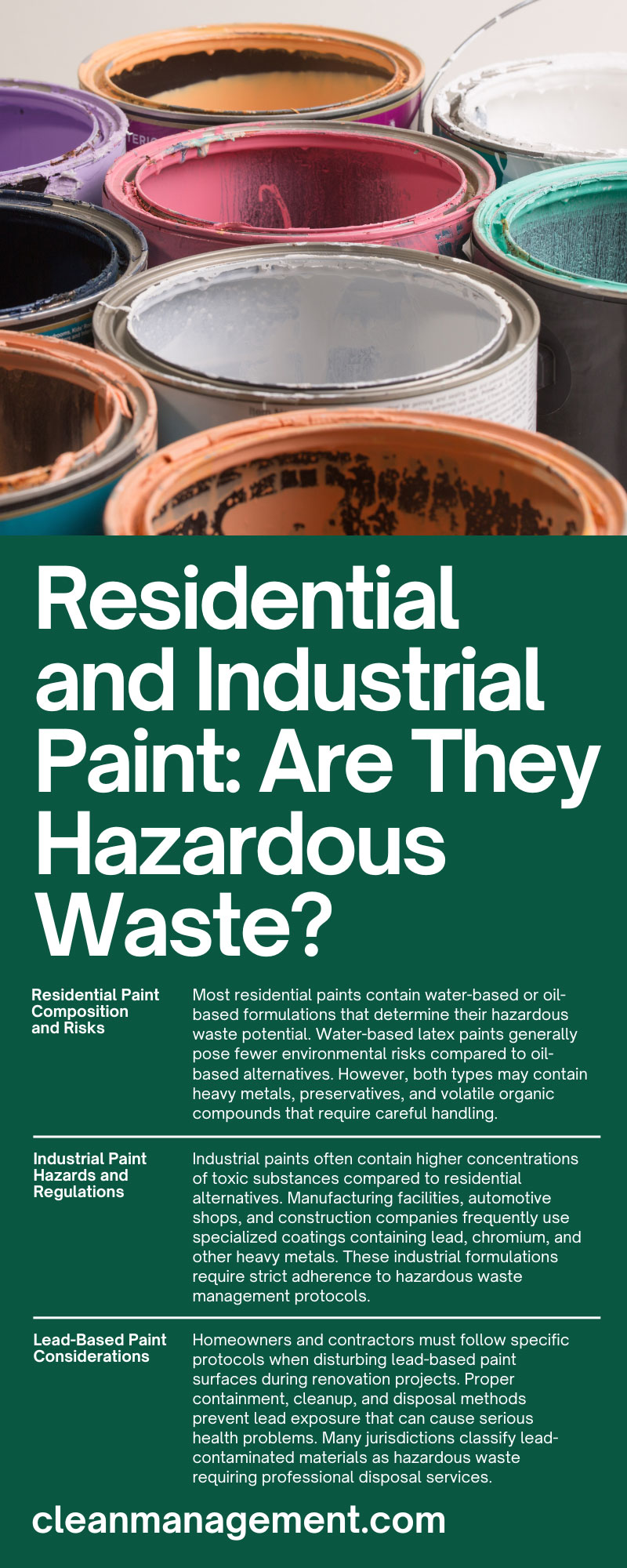Residential and Industrial Paint: Are They Hazardous Waste?

Paint disposal raises essential questions about environmental safety and regulatory compliance for homeowners and businesses alike. Understanding whether residential and industrial paints qualify as hazardous waste helps ensure proper handling and disposal practices. The classification depends on several factors, including paint composition, chemical content, and local environmental regulations.
Understanding Hazardous Waste Classification
Hazardous waste classification follows specific criteria established by the Environmental Protection Agency and state regulatory agencies. Materials qualify as hazardous waste when they exhibit characteristics of ignitability, corrosivity, reactivity, or toxicity. Paint products often contain volatile organic compounds, heavy metals, and other chemicals that may trigger these classifications.
The Resource Conservation and Recovery Act provides the framework for hazardous waste identification and management across the United States. This federal legislation establishes standards that states and local municipalities must follow when regulating waste disposal. Paint manufacturers must comply with labeling requirements that help consumers identify potentially hazardous products.
Residential Paint Composition and Risks
Most residential paints contain water-based or oil-based formulations that determine their hazardous waste potential. Water-based latex paints generally pose fewer environmental risks compared to oil-based alternatives. However, both types may contain heavy metals, preservatives, and volatile organic compounds that require careful handling.
Oil-based paints typically contain solvents that make them flammable and potentially toxic to human health and the environment. These solvents can contaminate soil and groundwater when disposed of improperly through regular trash or drainage systems. Even dried paint cans may retain residual chemicals that qualify them as hazardous waste in many jurisdictions.
Industrial Paint Hazards and Regulations
Industrial paints often contain higher concentrations of toxic substances compared to residential alternatives. Manufacturing facilities, automotive shops, and construction companies frequently use specialized coatings containing lead, chromium, and other heavy metals. These industrial formulations require strict adherence to hazardous waste management protocols.
Commercial paint operations generate larger volumes of waste materials that amplify environmental risks. Spray booth filters, contaminated rags, and paint sludge from industrial processes often qualify as hazardous waste. Businesses must maintain detailed records of waste generation and disposal to ensure regulatory compliance.
Lead-Based Paint Considerations
Older paint formulations manufactured before 1978 frequently contain lead, creating significant health hazards during renovation and disposal activities. Lead-based paint removal generates dust and debris that requires specialized handling procedures. The Toxic Substances Control Act regulates lead-based paint activities through the Renovation, Repair, and Painting Rule.
Homeowners and contractors must follow specific protocols when disturbing lead-based paint surfaces during renovation projects. Proper containment, cleanup, and disposal methods prevent lead exposure that can cause serious health problems. Many jurisdictions classify lead-contaminated materials as hazardous waste requiring professional disposal services.
Proper Paint Storage and Handling
Proper storage practices extend paint shelf life while minimizing environmental risks and disposal requirements. Sealed containers stored in temperature-controlled environments prevent degradation that can increase hazardous characteristics. Regular inventory management helps identify aging products that require disposal before they become problematic.
Paint containers should remain tightly sealed and stored away from heat sources, flames, and incompatible materials. Proper labeling helps identify contents and hazardous characteristics for future reference. These practices reduce the likelihood that stored paint will develop hazardous waste characteristics over time.
Disposal Methods for Residential Paint
Many communities operate household hazardous waste collection programs that accept residential paint for proper disposal. These programs provide safe alternatives to throwing paint in regular trash or pouring it down drains. Residents should contact local waste management authorities to learn about available collection events and drop-off locations.
Paint recycling programs offer environmentally beneficial alternatives to traditional disposal methods. Some facilities process latex paint into new products while others blend different colors into primer or base coats. Hazardous waste disposal in San Diego allows residents access to specialized disposal services through county-operated facilities and private contractors.
Commercial Paint Waste Management
Businesses generating paint waste must develop comprehensive waste management plans that address identification, storage, and disposal requirements. Generator categories depend on monthly waste volumes and determine applicable regulatory requirements. Large quantity generators face the most stringent requirements, including manifest tracking and annual reporting.
Professional waste management companies provide specialized services for commercial paint waste, including on-site pickup and proper disposal. These contractors maintain the necessary permits and expertise to handle various paint formulations safely. Businesses benefit from partnering with qualified contractors to ensure regulatory compliance and minimize liability.
For example, a mid-sized furniture manufacturer partnered with a licensed waste management provider to handle leftover solvent-based paints. This move not only streamlines compliance reporting but also reduces storage risks and frees up valuable floor space in their facility.
Environmental Impact of Improper Disposal
Improper paint disposal creates lasting environmental contamination that affects soil, groundwater, and surface water resources. Paint components can persist in the environment for decades, gradually leaching into surrounding areas. These contaminants pose risks to wildlife, vegetation, and human populations that depend on clean water sources.
Landfills receiving improperly disposed paint face increased risks of groundwater contamination and air emissions. Municipal wastewater treatment systems cannot effectively remove paint components that enter through the drain disposal. Prevention through proper disposal practices protects these critical infrastructure systems from contamination and operational problems.
Regulatory Compliance Requirements
Federal, state, and local regulations establish specific requirements for paint waste management that vary by location and generator type. Businesses must understand applicable requirements to avoid violations that can result in significant penalties. Regular training helps employees recognize hazardous characteristics and follow proper handling procedures.
Documentation requirements include waste characterization, manifests, and disposal records that demonstrate regulatory compliance. Regulatory agencies conduct inspections and audits to verify proper waste management practices. Maintaining accurate records protects generators from potential enforcement actions and demonstrates environmental stewardship.
Alternative Paint Options
Low-VOC and zero-VOC paint formulations reduce environmental impact while maintaining performance characteristics required for various applications. These alternatives contain fewer toxic components, which can help classify finished products as hazardous waste. Manufacturers continue developing innovative formulations that balance performance, durability, and environmental considerations.
Natural and bio-based paint ingredients offer additional options for environmentally conscious consumers and businesses. These products utilize renewable resources and biodegradable components that reduce long-term environmental impact. While performance characteristics may differ from conventional paints, these alternatives provide viable options for many applications.
Making Informed Disposal Decisions
Understanding paint composition and local regulations helps consumers and businesses make informed decisions about disposing of residential and industrial paint. Reading product labels provides essential information about hazardous characteristics and recommended disposal methods. When in doubt, treating paint as dangerous waste ensures environmental protection and regulatory compliance.
Professional consultation provides valuable guidance for complex disposal situations involving large quantities or unknown paint types. Environmental consultants and waste management professionals offer expertise that helps identify appropriate disposal methods. This investment in professional guidance prevents costly mistakes and ensures proper ecological stewardship.

